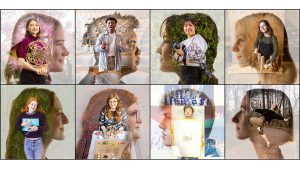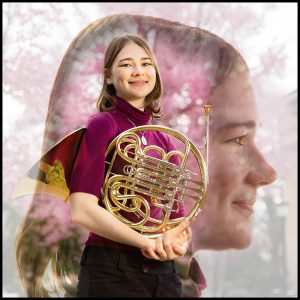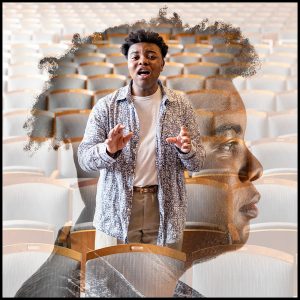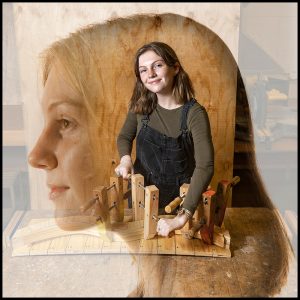From dancing to singing to 3D printing, our students tap into their creative side to explore the world around them.

You don’t need to be an art or music major to flex your creative muscles.
Whether it’s videography, wood sculptures or journaling, Tar Heels from all majors are tapping into their creativity to explore complex topics, express themselves and connect with the community.
Meet some of our creative Tar Heels and learn more about their artistic outlets

Video journalism
“My relationship with my camera almost always involves other people. I grew up consuming stories and documentaries about people around the world, and I value that video journalism allows people to tell their own stories. I have made some amazing relationships through my work and am forever grateful. Along the way, I realized how exciting it is to be a part of a collaborative process that continues to challenge me creatively. I tend to relate more to visual art than I do words, which I think is why I like to find creative ways to evoke emotion and empathy through my filming and editing. I want to touch on those nebulous feelings that we all have but can be hard to bring to the surface sometimes.
“Although most of my films are about other people, filmmaking has taught me a lot about myself. It brings me comfort to know I can share a deep human connection with someone through this medium, even if externally, that we are nothing alike. It’s a haven I know I can always return to it even if I don’t have direction because every time I pick up the camera, I’m grateful I did. My favorite thing about filmmaking is community. I feel privileged to have met some amazing people who have become dear friends to me. The people I learn beside at UNC are not only incredibly talented visual artists themselves but are once-in-a-lifetime kind of people. Even those who I’ve never met already in the field, I feel a comforting network of support from and am continually inspired by the work they create. There are always challenges in this work, but I’m grateful I’m not in it alone.”
Hope Davison, senior studying media and journalism, global studies and Japanese

3D printing and custom fabrication
“BeAM and 3D printing are so important to me because it allows me to express myself in ways that I’ve never had access to before. I can fabricate custom pieces for my wheelchair — like cupholders and side guards — that not only look really cool but are functional and accessible. My favorite part of 3D printing or laser cutting is the moment that something I’ve designed from scratch comes to life. I love the trial and error process of prototyping a 3D-printed design because once you get it right and have a successful iteration, you feel so proud and excited that something you designed is working. BeAM has given me the opportunity to make pretty awesome things and make my world a little more accessible.”
Sarah Ferguson, sophomore studying biology and neuroscience

Visual art
“Art allows me to express complicated issues that I struggle to vocalize but that are integral to how I view the world around me. As a queer and nonbinary identifying Southern artist, I grew up in predominantly heteronormative and conservative spaces, which early on led me to believe that I was in some way damaged or deficient due to my inherent malignment with these ideals. As I began to learn about ways that politics and structures of power reinforced these cultural attitudes, art provided a way for me to address these interconnected issues in a way that can start conversations and provide much-needed representation for queer experiences. My work with queer spaces, specifically, has given me the space to engage with issues such as sexuality, gender, politics and social constructions. In these ways, my work is a means of expressing my experiences and trying to make sense of social issues based on historic events, movements and values.
“I love working with paint because it provides so many expressive options in terms of gesture, texture and color that always seem related back to the artist’s hand, which can be a powerful subconscious tool in conveying humanness in visual narratives. The options are seemingly endless, and I fell in love with the ability to turn a blank canvas into a work of art that can make people feel deeply about the subject matter. I am also really drawn to the ability of color and light in my paintings to represent psychological experiences within both queer and non-queer spaces.”
Chris Smith, senior studying studio art

Music
“Music has long been a part of my life — a language, a mother tongue. My mother brought me into the world of music. The more familiar I become, the more I am surprised at the potential and nuance available to musicians who speak this language. Music is where my teachers taught me to be kind to myself and enjoy the journey because, certainly, music is about more than the minutes of sound made in the performance. There are hours and days and years spent practicing and experimenting. My horn and piano teachers have all urged me to make longer phrases. It seems to me that my time as a musician has been my longest phrase. Time is meant for music, in all of its immaturity, in the silence between the notes and for sincere communication. I think more than allowing me to express myself, being a musician has helped me discover a self worth expressing.”
Monet Thérèse Jowers, sophomore studying biology and music performance

Modern dance
“As many girls were, I was enrolled in ballet classes as a small child. No other hobby has taken quite like it. Dance has always been an integral part of life, no matter the style I was obsessed with at the time. I began with jazz, moved into modern, threw myself into ballet, and finally returned to modern dance at UNC.
“Dance is unique compared to other styles because, unless it’s an actual dance competition, you are only competing with yourself. As a space where I felt safe to grow and improve, I found my academic ambitions and work ethic through dancing. Dance was not an outlet for me, but rather it was a place for me to strive toward personal goals. I am now dancing one-third of what I was dancing in high school. However, I can still count on it to be a space where I can create goals other than academic goals. Got a B on a test? I can always count on the studio and my body to be there to create something I am proud of.”
Sarah Wooster, sophomore studying statistics and operations research

Singing
“Singing is important to me for many reasons, but mostly because it is a means of expression and connection. I am in an a capella group, and I feel that singing has allowed me to connect with them on an emotional level. I also feel like singing and performing is something that you can always get better at and something that one can actually improve upon.
“There have been times when I didn’t know how I was feeling or how to express to other people how I was feeling, but then I would sing to myself, and it would provide so much clarity. I feel like it allowed me to articulate my emotions to other people. Sometimes I’ll have a whole bunch of pent-up feelings or emotions, and singing allows me to release it all. Some of my core memories from stressful times — applying to college or waiting for the results of something — would be me belting my heart out in the shower or driving down the highway at night with the windows down, belting away.”
Cameron Davis, first-year student studying classical vocal performance and chemistry

Wood sculpture
“Art has been a constant in my identity for my entire life. As I’ve grown up, I’ve traded in popsicle sticks and hot glue for raw wood and power tools.
“My passion for wood sculpture is in conjunction with my love for nature. I grew up exploring the outdoors and admiring the pine trees of my hometown, and I feel a deep connection with wood. I’ve found that I enjoy expressing myself through wood sculpture because of that personal connection. Through sculpture, I express my perspective and reflect on it as I make a piece of art. I’ve used wood sculpture not only as an outlet for self-expression but also as a meditative practice, finding peace in the process. Wood sculpture has been incredibly important to me because it grounds me by giving me the space to express myself and to reflect upon my perspective and beliefs.”
Sarah Ellen Dean, first-year student studying studio art and environmental science

Journaling
“Journaling allows me to explore both my creative processes and my emotions through writing. I love sitting down outside and taking inspiration from the world around me when I write. It is a means of expression for me and allows me to explore my life experiences creatively. I love incorporating visual art into my journals as well. When I’m traveling, I collect ephemera to collage with in my journal. It adds a lovely visual element to my writing.”
Sadie Allen, sophomore studying studio art, advertising and creative writing
